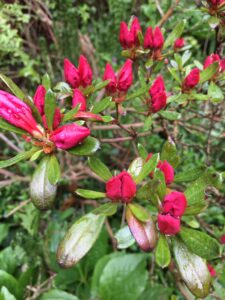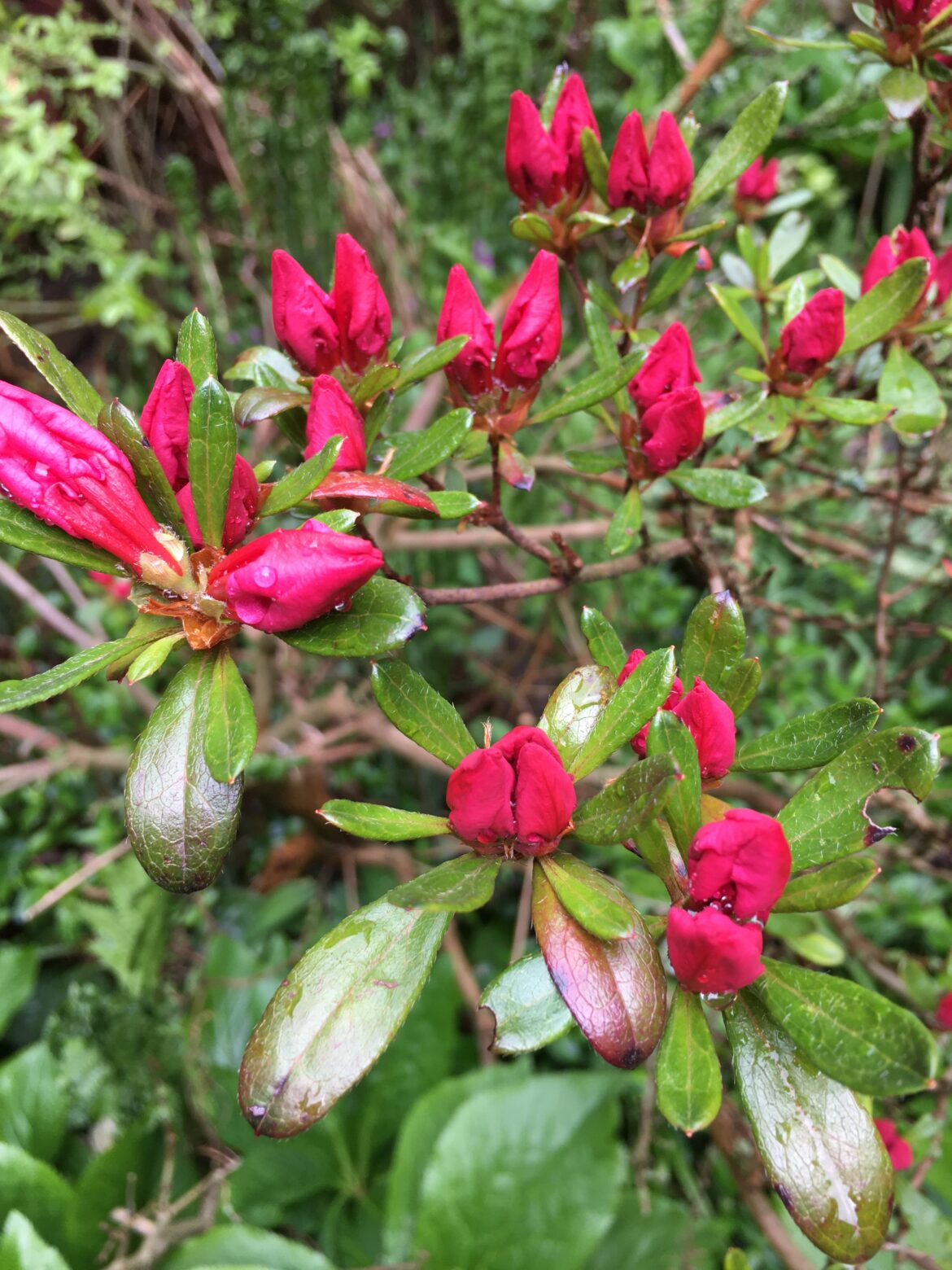May 4th
The 124th Day of the Year
Come, we’ll abroad: and let’s obey
The proclamation made for May,
And sin no more, as we have done by staying.
But, my Corinna, come, let’s go a-Maying.
Robert Herrick
Sunrise/set: 5:32/7:32
Day’s Length: 14 hours
Average High/Low: 69/47
Average Temperature: 58
Record High: 88 – 1902
Record Low: 28 – 1903
Weather
As the first cold front of the month moves into West Virginia and Pennsylvania, high temperatures warm into the 80s twenty percent of the time and into the 70s another 20 percent throughout the Lower Midwest. Sixties occur 45 percent of the days, and highs only reach the 50s on 15 percent of the afternoons. Rain comes one year out of three, and skies are overcast 40 percent of the time. Chances of frost are just five percent.
Natural Calendar
Along the Eastern seaboard, horseshoe crabs are mating, their numbers especially great when the moon is either new or full and the tide is high. Along the 40th Parallel, some touch-me-nots have six leaves, some eight in average years. Knotweed is chin high, hops eight feet. The most precocious poppies have opened. Poplars are well leafed now, and the rest of the tree line is a pale, glowing green. Redbuds get seed pods; scarlet pimpernel opens below them. Clustered snakeroot season starts in the new shade. Eastern wood pewees arrive. Northern spring field crickets have hatched in milder years.
The Shooting Stars
Before dawn, the Eta Aquarid meteor shower brings between ten and 40 shooting stars a minute through Aquarius.
Daybook
1982: Lily-of-the-valley season is just beginning in the middle of hydrangea season. Sedum is blooming, the high canopy filling.
1983: Dogwoods and redbuds in bloom throughout the village. Ragwort and phlox give the lower woods their dominant colors, gold and purple. Three butterflies seen today, one cabbage white, one orange sulphur, one black swallowtail. Rhubarb flowers opening.
1984: Buckeye and dogwood full bloom.
1986: Lily-of-the-valley full bloom. Jack-in-the-pulpits are strong. Oaks appear to open just a little. Hydrangea season. Purple buds on the sweet rockets. They’ll bloom this week. First sedum, sweet Cicely, early golden Alexander. Angelica, heavy and succulent, is up to my knees. Thin-leafed coneflowers nine inches, wild petunias four inches. First daisy opens at the south wall. From Grand Lake St. Marys about 100 miles to the north, I received a report that about a third of the goslings are born. They will peak mid May, be all hatched by the first of June.
1987: First sweet rockets open.
1988: Hosta is seven inches, pacing the pokeweed. Ferns unwinding. Cherry flowers falling in the wind, at least half gone. At South Glen, the purple deadnettle is reddening. Penny cress is growing so tall, tall as the winter cress, changing the color of the pasture from its bright, rich, April white and gold to May’s green (until the clovers bloom). Redbud still full bloom now, apples and crabs too.
1989: Cherry blossoms almost gone, apples staying near full. Sedum blooming under the high canopy.
1990: End of most flowering fruit trees in town.
1991: First raspberries and locusts bloom. First scorpion fly.
1993: Maggie calls from Madison, Wisconsin: bloodroot gone, bluebells and tulips full, Dutchman’s britches full, Jack-in-the-pulpit just out of the ground. Here in Yellow Springs, spring beauties have disappeared, and the blue bellflowers all withered in the last 24 hours. The pyrethrums, geums, astilbe, sweet rocket and daisies have budded, the next tier of flowers ready to replace the last of the daffodils and tulips. Forget-me-nots are at their peak. They are a good transition flower between middle spring and Late Spring. The first two ranunculus opened today. Redbuds and apples still full bloom, apple blossom scent heavy. Pears mostly leafed, many cherries holding. The canopy is half in at Wilberforce, the forest laced with sky and green. Still the luminescent glow of April persists, the violets and pinks and pale greens. Full moon tonight.
1999: Frogs still call. Now bridal wreath is best, and the leaves fill in quickly overhead. Color remains that of bright middle spring, but it is multiplied now by the fattening canopy.
2000: Sweet Cicely in bloom in the south garden.
2001: Orchard grass emerges from its sheaths, so sweet for chewing.
2003: Doves and cardinals both singing at 5:55 a.m. Late tulips still strong in some town gardens.
2005: Redbuds and lilacs hold at full, and most crabapples. The bush crabapples at the triangle park just opened a day or two ago. American beech just starting to leaf. Late tulips hold on very strong in this cool weather. Wood hyacinths open beside them. Pink quince all in bloom, as the red quince flowers fall.
2006: Allium and late red tulips are in full bloom in the yard, allium lush in front of Liz’s house on Stafford Street. The bright purple of the redbuds has become dull as the flowers cede to leaves.
2007: Allium buds starting to unfold. Chives buds big and fat (they pace the allium). First pink and violet anemones open as the wood hyacinths reach full bloom. Bridal wreath spirea and snowball viburnum seen for several days around town. Doves mating this morning before dawn, the fourth day in a row that I have seen the ritual. All the redbuds, their flowers killed in early April, are leafing out pretty much on schedule. An indigo bunting visited the backyard bird feeder when Jeanie and I were sitting out about 10:00 a.m., the first time we had seen a bunting here.
2008: A flock of maybe a dozen grackles in Mrs. Timberlake’s tree about 10:00 this morning. Iris in the yard well budded; the plants have spread, maybe doubled since last year. Osage trees are barely budded now. Redbuds losing their luster. Red azaleas in the front garden are coming in. The first violet Indian hyacinth opened at about 2:00 this afternoon. Baltimore oriole heard singing in the back trees this afternoon, red-bellied woodpecker on and off. Honeybees humming in the full-blooming pink quince tree by the pond. All of the red quince flowers are gone.
2010: Poppy buds at home, several peony buds cracking, but full bloom of poppies and peonies on Elm Street. Silver olive bushes covered with flowers along the highway south to Xenia. Clematis seen full near downtown. At home under the honeysuckle, the bluebells are almost done. Ranunculus in bloom in front of Don’s house, sweet Cicely opening in the alley.
2011: Very first Korean lilac flower. Pink quince full bloom. Our red crabapple blossoms hold well, but petal fall continues at the park. Sweet Cicely barely open. Red quince gone.
2012: Robins very loud from at least 4:30 on this morning. Cardinals once at 5:15, but not prominent at all today. Rhythmic sparrow chanting from 6:00. A hummingbird visited the red feeder today, the first time one has come this close. The first scorpion fly seen in the rose bushes. The second silver-spotted skipper seen in the south garden.
2013: The first pale violet iris seen in bloom at the south side of the house at the corner of Stafford and High. Sweet Cicely is budding in the Phillips Street alley, across from the budding poppies. A brief glimpse of a black swallowtail before I went to work at 10:00. Casey called in the afternoon: He saw the first hummingbird of the year.
2014: In Goshen, Indiana, 200 miles northwest of Yellow Springs, Judy saw “four colors of violets, lavender, yellow ones, carpets of early meadow rue, large-flowered trillium (some just emerging) and toad trillium, spring beauties, one set of Dutchman’s britches, some not even blooming.” Quite a difference from here in Yellow Springs where the Dutchman’s britches were gone a month ago.
2015: Warmth settles across the country. Inventory in the yard: Virginia bluebells and white bleeding heart still full bloom, perennial salvia with small heads, one iris bud, early wild geraniums, the red crab apples full but shedding, red azaleas ready and first one open in the afternoon, Lenten roses full bloom, Peggy’s Korean lilac and our pink quince blossoming, garlic mustard and lamium full, common fleabane with first blossoms, some bamboo at eight feet, star of Bethlehem and celandine early full, some Joe Pye sprouts reaching a foot, Endless Summer hydrangea leaves beginning at the base, Liz’s first two alliums in bloom, rhubarb half size, Indian hyacinths opening, wood hyacinths starting (so the time of late-spring blue flowers begins), an adult mourning dove with a fledgling (half the size of its guardian) beside it feeding at the feeder, then drinking at the birdbath together. At Antioch, dandelions to seed, apple petals coming down. In Moya’s front yard, some of the yellow tulips survive in the middle of her surging weeds. In his yard on the north edge of town, Peter Hayes saw a male and a female Baltimore oriole. The female was carrying nesting material in her beak.
2016: Full dogwoods by the Mills Park Hotel and about town, full snowball viburnum time in the yard and at Don’s and more, wisteria flowering at Park Meadows, weigela starting in front of Mateo’s house, my weigela budding, the latest tulips holding in the north garden. Through the countryside, remaining patches of dandelions have gone to seed. Liz reports visits by a female rose-breasted grosbeak from the 2nd through today.
2017: Spoleto, Italy, walking with Tat and Neysa and Ivano in the hills around Campello: Bright orange poppies along the road, climbing roses and rosemary vines full bloom and common, red cyclamens, two varieties of ginestra (but not the thorny kind), winter grain still deep green but heading up well, purple flowers like snapdragons on single hairy stalk with opposite, entire creased leaves, some buttercups, a few iris, a patch of delicate vinca-like plants, four star of Bethlehems. At Fontanelli, vineyards had only a few inches growth, seemed behind those in Galicia a week ago. And no jasmine in bloom.
2019: Petalfall intensifies, petals, pink and white, swept and mounded along the alleys and sidewalks by the yesterday’s tide of rain and flooding. Bugleweed (Adjuga reptans) is flowering in the lawns. Star of Bethlehem bloomed in the garden overnight. Waiting for Jill in her driveway, I saw two squirrels mating again and again in her silver maple tree. At Ellis, cypress trees have one-inch foliage. The ash grove is just starting to show pale green, but the sugar maple grove is almost completely leafed. On the way to Dayton, several huge gray fields of dandelions gone to seed.
2020: Liz’s garden has round purple alliums open, mine still just budded. The first wood hyacinths and Indian hyacinths are starting to open in the circle garden. So much is the same as in years past, especially as in 2015.
Although a life of retreat offers various joys, none, I think, will compare with the time one employs in the study of herbs, or in striving to gain some practical knowledge of nature’s domain.
Walafrid-Strabo, Hortulus, 9th Century A.D.


